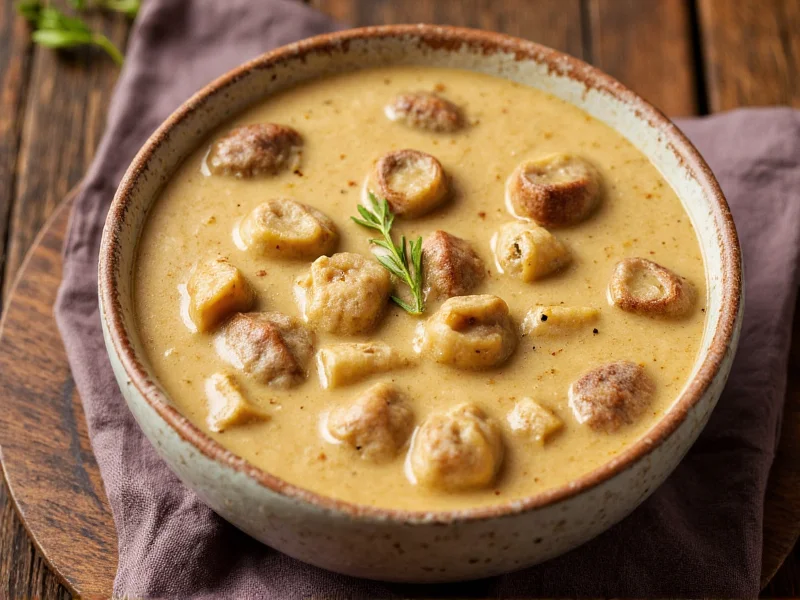The Authentic Origins of Stroganoff Soup
While beef stroganoff as a main course is widely recognized, the soup variation represents an interesting culinary adaptation of the original 19th century Russian dish. Created for the wealthy Stroganov family, traditional stroganoff was a sautéed beef dish with mustard and smetana (Russian sour cream). The soup version emerged later as home cooks experimented with transforming the rich sauce into a broth-based preparation, particularly popular in Eastern European communities and later adapted in American kitchens during the mid-20th century.
Essential Ingredients for Traditional Stroganoff Soup
The magic of authentic stroganoff soup lies in its carefully balanced ingredients. Unlike simplified versions that merely dump sour cream into broth, true stroganoff soup builds flavor through multiple stages of preparation. The foundation requires specific components that work together to create that distinctive tangy, savory profile.
| Core Ingredient | Traditional Role | Quality Considerations |
|---|---|---|
| Beef (chuck or sirloin) | Provides rich meaty flavor base | Cut against the grain for tenderness |
| Button mushrooms | Earthy umami component | Fresh preferred over canned for texture |
| Yellow onion | Sweetness and aromatic foundation | Finely diced for proper integration |
| Beef broth | Liquid base with depth | Homemade preferred; low-sodium commercial if needed |
| Sour cream (smetana) | Signature tangy creaminess | Full-fat, added off-heat to prevent curdling |
| Dijon mustard | Traditional flavor enhancer | Essential for authentic taste profile |
Traditional Preparation Method
Creating authentic stroganoff soup requires attention to technique, not just ingredients. The process begins with properly searing the beef in batches to develop fond (those delicious browned bits) without overcrowding the pan—a common mistake that leads to steamed rather than seared meat. After removing the beef, mushrooms and onions are sautéed until deeply caramelized, which builds the essential flavor foundation.
The next critical step involves deglazing the pan with a small amount of broth or wine to incorporate all those flavorful browned bits. Many home cooks skip this crucial step when making stroganoff soup from scratch, resulting in a one-dimensional flavor profile. The liquid should be simmered while scraping the bottom of the pan to fully incorporate the fond.
Avoiding Common Stroganoff Soup Mistakes
Several pitfalls can ruin an otherwise promising stroganoff soup. The most frequent issue involves sour cream curdling, which happens when it's added directly to hot soup. To prevent this, always temper the sour cream by gradually mixing in small amounts of warm broth before incorporating it into the main pot. Another common error is overcooking the beef—since it will continue to cook in the hot soup, it should be seared rare to medium-rare before adding to the broth.
Many modern recipes for creamy mushroom stroganoff soup skip the traditional mustard component, but this ingredient provides essential depth that balances the richness. Authentic Russian stroganoff soup recipes always include some form of mustard, whether Dijon or the traditional Russian mustard made with horseradish.
Variations Across Cultures
While traditional Russian stroganoff soup features beef, regional adaptations have emerged worldwide. In Ukraine and Poland, you'll often find versions with pork instead of beef. Scandinavian adaptations sometimes incorporate dill and lemon for brightness. Americanized versions frequently include Worcestershire sauce and paprika, neither of which appear in authentic Russian preparations.
For those seeking vegetarian stroganoff soup alternatives, portobello mushrooms provide excellent meaty texture, while coconut milk can substitute for sour cream in dairy-free versions. However, these adaptations significantly alter the traditional flavor profile that defines authentic stroganoff soup.
Serving and Storage Recommendations
Stroganoff soup achieves its ideal texture when served immediately after the sour cream has been incorporated. The traditional presentation includes a bed of buttered egg noodles with the soup ladled over top, though some prefer to serve the noodles on the side. A sprinkle of fresh dill or parsley provides the perfect finishing touch that balances the richness.
When storing leftovers, keep the soup and noodles separate to prevent sogginess. Properly stored in an airtight container, stroganoff soup maintains quality for 3-4 days in the refrigerator. For best results when reheating stroganoff soup, warm gently over low heat without boiling, as high temperatures can cause the dairy to separate. Freezing is possible but may affect the texture of the sour cream component.
Perfecting Your Stroganoff Soup Technique
Mastery of stroganoff soup preparation comes from understanding the why behind each step. The searing process isn't just about cooking the meat—it's about creating complex flavor compounds through the Maillard reaction. The slow caramelization of mushrooms develops umami compounds that form the soup's flavor backbone. Even the order of ingredient addition matters: onions before mushrooms prevents the mushrooms from becoming waterlogged.
For those wondering about the best cut of beef for stroganoff soup, chuck roast offers ideal marbling and flavor, though sirloin works well for quicker cooking. The key is cutting against the grain into thin strips no wider than ¼ inch, which ensures tenderness despite the relatively short cooking time compared to stewing cuts.











 浙公网安备
33010002000092号
浙公网安备
33010002000092号 浙B2-20120091-4
浙B2-20120091-4